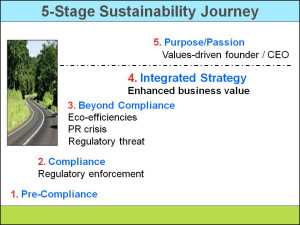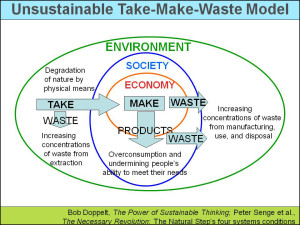Aug 3rd, 2010 by Bob Willard
In my July 27, 2010, blog , I described the 5-stage journey that a business follows as it moves from being an unsustainable enterprise in Stages 1, 2 and 3, to being a sustainable enterprise in Stages 4 or 5 (see the above slide). Labeling companies in the first three stages as “unsustainable” deserves further explanation, especially for Stage 3 companies. We will use the 3-nested-dependencies model of sustainability, described in my July 20 blog , to show four reasons why today’s take-make-waste model of commerce is unsustainable.
2. Excessive waste accumulates from the things we dig up
Extractive companies like mining and oil-and-gas companies notoriously leave “tailings” and other waste behind. Business schools use case studies from around the world that highlight the destructive effects of mining and drilling operations on the environment and communities. Refineries and smelters create more air, water and soil pollution. When we use / burn these natural resources for fuel, further waste is produced. So, most companies contribute—directly or indirectly through their supply chains—to the systematic increase in concentrations of waste from substances extracted from the earth’s crust. This is especially alarming when the concentrations of heavy metals, fossil fuels and byproducts get too high. These days, companies can acquire permits to pollute so that their actions comply with regulations (Stage 2). But, these legal actions are still not sustainable. Sooner or later, we are in danger of drowning in our own waste, poisoning ourselves to death, and upsetting long-standing, essential natural equilibriums, like our climate.
3. We create excessive waste from things we make
Similarly, the current rules of the business game allow companies to pollute the air, water, and soil as they make things. Through the production and use of chemicals and toxic synthetics, companies directly or indirectly contribute to the relentless increase in concentrations of hazardous and non-hazardous waste. Today, there are over 70,000 chemicals, dioxins, and PCBs. A century ago, this wasn’t a problem because we didn’t have these man-made pollutants. Now, there are thousands of these health threats. We need to change the rules that allow companies and consumers to externalize the environmental and social costs of this pollution. Such excessive and dangerous polluting is simply unsustainable.
4. Peoples’ needs are prevented from being met
Many business models today contribute—directly or indirectly—to abuses of political or economic power, resulting in unmet human needs for clean air, potable water, nutritious food, adequate shelter, and quality of life. According to Metrics 2.0, the richest 1% owned 40% of global assets in the year 2000, and the richest 10% accounted for 85% of the world’s total assets. In contrast, the bottom 50% of the world’s adult population owned barely 1% of the total global wealth. This chasm has grown in the last ten years and is continuing to widen. Such disparities create social unrest and violent desperation as basic living needs become harder and harder to meet. Something’s got to give. The business models that encourage over-consumption by the haves at the expense of the have-nots is unsustainable.
To recap, today’s take-make-waste business model is no longer feasible. It violates all four of The Natural Step’s systems conditions for a sustainable society.
The old business model was created during the Industrial Revolution. As described by William McDonough and Michael Braungart in their 2002 book, Cradle to Cradle, companies with this system of production are designed to do the following:
Those practices and consequences are what companies were designed to do for the last 150 years. Perhaps, for a minority, that business model worked fine at first, but it’s no longer sustainable. The Earth’s ecosystem is in crisis. It threatens 100% of us. Over-consumption and poor management have resulted in unsustainable use of natural and social capital. Climate change will add further pressure on the natural systems—upon which all of our social systems and economies depend. Our time is limited to prevent a global “tipping point” that could impact all of humankind, including future generations, adversely and permanently.
Stage 3.0 companies slow down their degradation by releasing fewer pounds of toxic wastes into the air, soil, and water every year and producing smaller amounts of useless waste. Stage 3.0 companies are better—“less bad”—than Stage 1 and 2 companies; but, they are still locked in an unsustainable economic paradigm that causes too much collateral damage in the environmental and social spheres. We need a more responsible game plan.
Next week, we will propose a more sustainable business model.
Please feel free to add your comments and questions using the Comment link below.
Bob



No comments:
Post a Comment